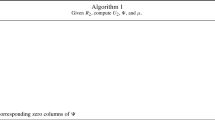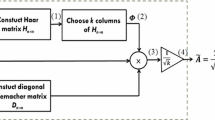Abstract
Determining the rank of a trilinear data array is a first step in subsequent trilinear component decomposition. Different from estimating the rank of bilinear data, it is more difficult to decide the significant number of component to fit the trilinear decompositions exactly. General methods of rank estimation utilize the information contained in the singular values but ignore information from eigenvectors. In this paper, a rank estimating method specifically for trilinear data arrays is proposed. It uses the idea of direct trilinear decomposition (DTLD) to compress the cube matrix into two pseudo sample matrices which are then decomposed by singular value decomposition. Two eigenvectors combined with the projection technique are used to estimate the rank of trilinear data arrays. Simulated trilinear data arrays with homoscedastic and heteroscedastic noise, different noise levels, high collinearity, and real three-way data arrays have been used to illustrate the feasibility of the proposed method. Compared with other factor-determining methods, for example use of the factor indication function (IND), residual percentage variance (RPV), and the two-mode subspace comparison approach (TMSC), the results showed that the new method can give more reliable answers under the different conditions applied.



Similar content being viewed by others
References
Smilde AK, Bro R, Geladi P (2004) Multi-way analysis: Applications in the chemical sciences. Wiley, New York, pp 23–34
Espinosa-Mansilla A, Pena AMDL, Gomez DG, Salinas F (2005) Anal Chim Acta 531:257–266
Jiji RD, Andersson GG, Booksh KS (2000) J Chemom 14:171–185
Bijlsma S, Smilde AK (2000) J Chemom 15:541–560
Pravdova V, Walczak B, Massart DL, Robberech H, Cauwenbergh RV, Hendrix P, Deelstra H (2001) J Food Composition and Analysis 14:207–225
Pravdova V, Boucon C, Jong SD, Walczak B, Massart DL (2002) Anal Chim Acta 462:133–148
Booksh KS, Kowalski BR (1994) Anal Chem 66:782A–791A
Kruskal JB, Harshman RA, Lundy ME (1989) Rank, decomposition, and uniqueness for 3-way and N-way arrays. In: Coppi R, Bolasco S (eds) Multiway data analysis. Elsevier, Amsterdam, pp 7–18
Faber NM, Bro R, Hopke PK (2003) Chemom Intell Lab Sys 65:119–137
Andensen CM, Bro R (2003) J Chemom 17:200–215
Tucker LR (1966) Psychometrika 31:279–311
Harshman RA (1970) UCLA working papers in phonetics, pp 1–84
Scanchez E, Kowalski BR (1990) J Chemom 4:29–45
Linder M, Sundberg R (2002) J Chemom 16:12–27
Wu HL, Shibukawa M, Oguma K (1998) J Chemom 12:1–26
Jiang JH, Wu HL, Chen ZP, Yu RQ (2000) J Chemom 14:15–36
Chen ZP, Wu HL, Jiang JH, Yu RQ (2001) J Chemom 15:439–453
Chen ZP, Wu HL, Jiang JH, Yu RQ (2001) J Chemom 15:149–167
Malinowski ER (2002) Factor analysis in chemistry, 3rd edition. Wiley, New York, pp 73–130
Meloun M, Capek J, Miksik P, Brereton G (2000) Anal Chim Acta 423:51–68
Wasim M, Brereton RG (2004) Chemom Intell Lab Syst 72:133–151
Bro R (1997) Chemom Intell Lab Syst 38:149–171
Harshman RA, Lundy ME (1984) Data preprocessing and the extended PARAFAC model. In: Law HG, Snyder CW Jr, Hattie J, McDonald RP (eds) Research methods for multimode data analysis. Praeger, New York, pp 216–284
Louwerse DJ, Smilde AK, Kiers HAL (1999) J Chemom 13:491–510
Chen ZP, Liu Z, Cao YZ, Yu RQ (2001) Anal Chim Acta 444:295–307
Bro R, Kiers HAL (2003) J Chemom 17:274–286
Xie HP, Jiang JH, Long N, Shen GL, Wu HL, Yu RQ (2003) Chemom Intell Lab Syst 66:101–115
Xie HP, Jiang JH, Shen GL, Yu RQ (2002) Comput Chem 26:183–190
Ding YJ, Wu HL, Fang DM, Cui H, Sun XY, Xia AL, Hu LQ, Yu RQ (2005) Chem J Chinese Universities 26:1255–1257
Xin MT (1989) Anal Chem 61:2219–2224
Acknowledgement
The research was financially supported by the National Natural Science Foundation of China (20375012 and 20475014).
Author information
Authors and Affiliations
Corresponding author
Rights and permissions
About this article
Cite this article
Hu, L., Wu, H., Jiang, J. et al. Use of pseudo-sample extraction and the projection technique to estimate the chemical rank of three-way data arrays. Anal Bioanal Chem 384, 1493–1500 (2006). https://doi.org/10.1007/s00216-006-0307-7
Received:
Revised:
Accepted:
Published:
Issue Date:
DOI: https://doi.org/10.1007/s00216-006-0307-7




